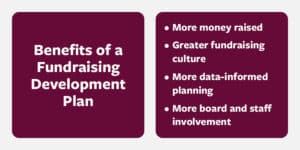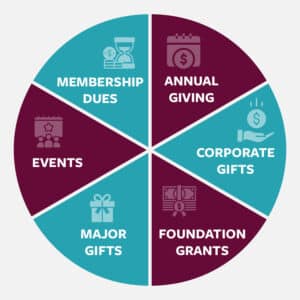
General Dwight Eisenhower once said, “In preparing for battle I have always found that plans are useless, but planning is indispensable.” Having an annual development plan helps you define not just what your fundraising goal will be, but also what key steps and metrics you need to have in place to successfully reach that goal.
It’s a competitive nonprofit landscape out there. Staff bandwidth is often limited and overstretched. Boards and CEOs don’t always see themselves as “fundraisers.” Giving USA reports each year show that total giving is on the rise, yet nonprofits on average lose more than 60% of their donors every year.
What is a Fundraising Development Plan?
A fundraising development plan is a strategic roadmap that guides nonprofits towards achieving its fundraising goals. It outlines a multi-year approach for cultivating donors, securing financial resources, and maximizing long-term sustainability. This plan analyzes past fundraising efforts, identifies ideal donor segments, and establishes clear strategies for acquisition, retention, and upgrade of donors. Essentially, it’s a blueprint for building a thriving donor base that fuels the organization’s mission and impact.
A development plan is the antidote to uncertainty. It serves as a thoughtful road map to set fundraising priorities and effectively utilize all the resources at your fingertips.
Fundraising development plans are even backed by science:
- Conducted in 2020 by Dr. Adrian Sargeant and the Institute for Sustainable Philanthropy, this study explored the role of development plans in an organization’s fundraising success. There has been plenty of anecdotal evidence that organizations that have written fundraising plans tend to have more consistent results of growth and success.
- This study was the first of its kind exploring how fundraising development planning contributes to fundraising results. Not only did it assess how much the act of planning and the written development plan itself contribute to a nonprofit’s fundraising results, it also took a wider view to determine the other factors that play a role in a nonprofit’s fundraising thrivability.
It found that having a fundraising and development plan drive donor strategy enables the organization to:
- Create stronger donor engagement
- Set the stage for major gifts
- Lay the foundation for tomorrow by ongoing learning and iterating
- Build the practice of data-informed planning
- Show boards good fundraising practice
Whether your nonprofit has a fundraising development plan or not, here are some tips to help you build a stronger approach to raising more money and keeping more donors.

Fundraising Plans = More Money Raised
The overall conclusion was that there is a strong connection between having a formal annual strategic fundraising planning process in place and whether that nonprofit was successful in meeting its fundraising revenue goals. But having a fundraising development plan also led to a greater fundraising culture, more data-informed planning, a stronger commitment to sticking with the plan, and more involvement by board and senior staff in fundraising.
If we think about all the factors that motivate donors, a development plan becomes more like a playbook on how to build meaningful donor engagement that leads to increased retention and, ultimately, giving.
Development Plans Lead to Retention and Growth
A development plan becomes more than just a set of lists, calendars, and activities. It’s a strategic compilation of all the ways you can connect and communicate with your donors which, if done effectively, leads to increased revenue. The realism in a development plan comes from building next year’s projections off of current and past giving trends. Ask yourself how much can you grow your fundraising that’s realistic but also a little bit of a stretch?
Getting Started to Plan
The first step to building a good development plan starts with a discussion with your senior staff (executive director, board, development director, senior leaders). This may seem obvious, but development staff are often omitted from organizational financial decisions. As a development leader, you can share perspectives on what is realistic to raise given the context of your current and previous fiscal years’ fundraising trends.
When you’ve determined your goal for the next fiscal year, learn and grow from what’s worked and where you have untapped opportunities:
- Did you raise what your organization needed in past years? What contributed to your success? What held you back? What could you do differently?
- What’s your donor retention rate and average gift amounts? How has that tracked over the past couple of fiscal years?
- How does your fundraising revenue breakdown, and what were your fundraising expenses for each donor type?
- Annual Giving (mail and email appeals)
- Corporate gifts
- Foundation grants
- Major Gifts
- Events
- Membership dues
 You don’t want to repeat past mistakes or continue doing something that just isn’t yielding the results with the best ROI. Understanding how (and where) funds have been raised in the past helps you map out a solid plan to build your fundraising goals and strategies this year.
You don’t want to repeat past mistakes or continue doing something that just isn’t yielding the results with the best ROI. Understanding how (and where) funds have been raised in the past helps you map out a solid plan to build your fundraising goals and strategies this year.
Focus Your Development Plan On More Than Just Money Raised
Think about your development plan as building a stronger fundraising strategy in five key areas:
1. Create Greater Donor Engagement
It’s easy to become complacent and think that just because donors have chosen to invest in our cause, they will unconditionally support us and that when we ask again they will give. Nonprofits on average lose more than 60% of their donors each year because they don’t connect with their donors. Donors want to see, feel, and touch the impact their gifts are having.
Good donor engagement involves a regular calendar of touchpoints, updates, and communications that highlights stories of successes, results, and even failures. Annual reports, newsletters, special webinars hosted by your key program leadership, holiday and birthday cards are all examples of ways to enhance your relationships with your donors.
2. Set the stage for major gifts
Every organization no matter how small can and should be raising major gifts. A successful major gifts program does not focus on high net-worth individuals with no connection to your organization. In fact, you probably already know who your major (current and potential) donors are.
Your next major gift will likely come from one of these donors who has capacity and who has been supporting you for a long time (and not at particularly high levels) and may also have been involved as a volunteer. Carving out a little time for more personal interactions with these donors will help you qualify those who can make larger gifts down the road.
As a reminder, setting the stage for major gifts isn’t about an immediate ask. It’s about building genuine connections with these potential high-impact donors to make a transformational gift at the right time.
Not sure where to start? Here are some tips:
- Research and Identify: Seek individuals or foundations with a history of supporting causes aligned with your mission.
- Personalized Engagement: Go beyond generic mailings. Reach out personally, understanding their philanthropic interests. Invite them to exclusive events or site visits to deepen their connection to your work.
- Stewardship is Key: Develop a personalized plan tailored to each donor’s interests and giving priorities. Engage in regular, meaningful communication that goes beyond just fundraising.
- Demonstrate Impact: Showcase the transformative power of major gifts. Share compelling stories of how past donations have made a significant difference.
By nurturing these relationships and demonstrating your organization’s impact, you’ll lay the groundwork for these major gifts that will propel your mission forward.
3. Lay the foundation for tomorrow
Without question, your limited bandwidth should be focused on donor retention because once you lose the donors who already opted to give to you, it’s hard to get them back. That said, it is still important to plant the seeds for the next pipeline of donors to your organization.
The best potential new donor names are people who self-identify in some way or who are connected in some way to you. Perhaps it’s through a sign-up on your website, following you on social media, attendance at an event, or a visitor book if prospective donors can visit your facilities.
This is also a way board members and other volunteers can play a key role in introducing your organization to their networks. Every follower, volunteer, and new name that crosses your doorway should be considered a potential investor in your work. Welcome them.
4. Build a practice of data-informed fundraising
Metrics on any level are important because they give you the data to make informed decisions about where you can build off your successes and identify opportunities for improvement. To help you make your fundraising efforts as effective as possible, keep track of three key areas critical to effective fundraising:
- Donors’ Behavior and Giving Patterns
Analyzing donors’ behavior and giving patterns is crucial. By studying donation frequency, preferred channels, and motivations (i.e., responding to specific campaigns or matching opportunities), you can tailor your outreach and personalize communication. This fosters deeper connections and encourages continued support. - Return on Your Fundraising Costs (ROI)
Tracking the return on your fundraising costs (donations received vs. expenses incurred) is essential for financial accountability. Knowing which campaigns or channels yield the highest ROI helps you optimize resource allocation and maximize the impact of every dollar you spend on fundraising efforts. - Level of Your Leadership Engagement
Engaging your leadership team in fundraising is a powerful asset. Board members and key figures can leverage their networks, host events, or champion your mission to potential donors. Their involvement demonstrates a unified commitment and fosters trust, leading to increased support.
Compare a few fiscal years to offer the best picture of trends in your performance, so you can determine where you need to build on your wins and make course corrections. Think of metrics as the vital signs of your organization’s financial health.
-
Show Boards Good Fundraising Practices
Another important way to use the development plan to inspire more involvement in fund development by Board members is to chart giving trends of the board and set goals for each year. Reports like BoardSource’s Leading With Intent and the Evelyn and Walter Haas, Jr. Fund’s UnderDeveloped report cited that boards view themselves as very weak in fundraising and are a contributing factor to high staff turnover.
Similarly, this Institute for Sustainable Philanthropy report found that just 57% of respondents felt their boards were supportive, and fewer than half of respondents reported that all members of their board made a gift in the last year. Here are a few ways to demonstrate good fundraising practice with your boards:
- Instead of just reporting fundraising amounts raised in your board reports, regularly include metrics around general donor giving patterns and behaviors (like retention, for example). Fundraising revenue and donor metrics will paint a more comprehensive picture for board leaders that illustrates how fundraising is not just about “asking for money.”
- Set goals and metrics for board overall giving in your development plan as well. Metrics like average gift, giving participation percentages, total giving amount, tracked over a few fiscal years can offer insight to your board members of the importance they play in an organization’s success.
- Offer training on fundraising best practices, donor stewardship opportunities, and effective communication techniques. Educate your board on the latest trends and proven techniques. If you’re interested in training your board about fundraising, reach out to learn how we’ve worked with volunteer leaders to build their confidence in fundraising.
- Regularly share success stories with your board, highlighting specific fundraising achievements and the impact they have created. This reinforces the value of their involvement, and motivates them to become fundraising champions.
- Regularly review your development plan with your board to assess progress and make adjustments as needed. Being adaptable allows you to capitalize on new growth strategies and address any unforeseen challenges.
Fundraising Development Plans Help You See Around Corners
Fundraising is increasingly more competitive than ever. There are nearly 1.8 million nonprofits in the U.S. and while the amount of giving nationally is increasing each year, the number of donors and volunteers has been declining. If we could travel forward in time a year or two from now, what would we discover we should be doing differently today? How could we navigate this year to weather these times in the long run?
Spending the time to intentionally build a strategy for fundraising and sticking with a written development plan has been shown to increase revenue, increase donor retention, and create higher likelihood of staff retention. A development plan helps your nonprofit see around corners to better anticipate and weather factors that will affect your revenue.
To learn more about how you can create your organization’s development plan, visit www.whillconsulting.com.
